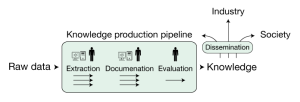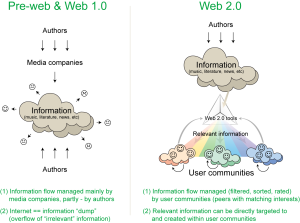A curious analogy arises when comparing the communication mechanisms employed by cells in multicellular organisms, and communication mechanisms developed by the human civilization. Of the main conclusions is that an open and transparent communication system might be critical for existence of a large multi[cellular] system.. What follows is based on some approximations, so has to be perceived with caution 😉
Generally speaking there are four communication (signaling) mechanisms in a multicellular organism:
1) Juxtacrine signaling (through direct contact), is facilitated by direct physical interaction between adjacent cells through membrane-anchored receptor molecules. Such receptors are the most essential tool for cellular communication. Together with membrane channels they facilitate environment sensitivity in all life forms and act as the fundamental building block within all inter-cellular communication systems.
2) Paracrine signaling (through chemical diffusion), is mediated by molecules secreted into the extracellular medium, which are sensed by the cells in vicinity of the emitting source. This enables information transfer beyond the cells in direct contact with one another. This signaling model is employed even by single-cell life forms and is considered to be an important step in emergence of multicellularity.
3) Circulatory–Endocrine signaling (through chemical circulation), is also mediated by molecules expressed into the intercellular medium, however in this case the range of signal transduction is considerably extended because of the signaling molecules being transported by the global circulatory system. This enables efficient intercellular communication on the scale of the whole organism.
In the present discussion “endocrine signaling” does not simply refer to animal endocrine systems modulated by specialized endocrine organs. It rather designates a general principle of information transfer when [any] cell in the organism is capable of sending signals to other cells via global circulatory system (e.g. including immune systems of animals and xylem/phloem systems of vascular plants).
Apparently, only the most primitive multicellular life forms lack circulatory endocrine systems – sponges, cnidaria (hydras, jellyfish, anemones, corals), comb jellies, flat and roundworms, “lower” plants (algae, moss, liverwort) and fungi.
4) Neurocrine signaling (rapid electrochemical signaling). An organism-wide communication system which, in addition to the chemoreceptive signal transduction, employs electrical polarization of neuron membranes as a mean of rapid signal transfer on the long distances. Besides of the fast reaction times, advanced nervous systems of higher animals provide learning and memorizing capacities, enabling rapid execution of complex responses crucial for survival in rapidly changing environmental conditions. Neurocrine signaling is an exclusive characteristic of the animal kingdom, and except sponges all multicellular animals have some sort of a nervous system.
graphics by Egor at whitelabdesign.com
~
Going back to the promised analogy, in the context of human society multicellular communication mechanisms can be paralleled to Speech, Writing, Web and Government:
1) Speech. Analogously to the juxtacrine signaling, spoken language facilitates communication between individuals upon direct contact with one another. Emerging approximately ~400-500k years ago, spoken language provided the key component for establishment of the human society, and facilitated increase in the organizational complexity of social holons from individual families to tribes. One can find some clear parallels between increased specialization of individuals in human tribes and of cells in multicellular colonies.
2) Writing and Printing. The emergence of writing enabled humans to communicate on a much larger distances and provided a robust mechanism for knowledge preservation. This advancement occurred approximately ~4 000 B.C. and is considered the central event in the emergence of human civilization. Admittedly, [Paracrine <> Writing] pair gives somewhat less striking correlation than [Juxtacrine <> Speech] in terms of the transportation method and stability of the “signal”. Nevertheless, from the communication perspective, writing indeed increased the efficiency of information transfer (both through space and through time), allowing more pronounced specialization of individuals and leading to establishment of increasingly complex social institutions. Telecommunication technologies of the 20th century increased the efficiency of information transfer even further, but those still remained within one-to-one (telegraph, phone) or one-to-many (radio and television) communication paradigms. And only after the advent of the World Wide Web a notable transition towards accessible many-to-many communication has started to evolve.
3) Internet & WWW. Having emerged 20 years ago, WWW not only delivers a global repository of human knowledge, but as well enables the most efficient world-wide communication mechanism. Similarly to the [circulatory+endocrine] systems in multicellular life forms, [internet+WWW] pair provides [infrastructure+standard language] for information transfer within a network of individuals. Current usability of this communication system is limited due to the information overflow problem, which emerges when one tries to perceive all the “signals” sent through the Web. However this is a technological rather than a conceptual problem, and modern social communication tools have already started to transform organizational and governance systems.
4) Government. In the communication context, government provides rapid coordination of extended groups of individuals when collective tribal meetings stop being practical. From this perspective it is very similar to animal nervous system – since it enables prompt reactions to rapidly changing environment conditions without necessity of gathering opinions from every individual in the group. During several thousands of years, much like the natural selection works, human society has sampled a substantial amount of governance systems. By trial and error excluding the unstable “phenotypes”, now society is slowly converging on a seemingly stable – democratic – architecture. In democratic arrangement all individuals {cells} are equally contributing to the coordination of the whole society {organism}, by sending relevant signals through their elected representatives {neighboring neurons of peripheral nervous system} to the government {central nervous system}. At least theoretically, in most democratic societies individuals indeed have an opportunity to contribute to the decision making process. However, even democratic form of governance does not seem to scale up properly in the absence of transparent and accessible communication channels.
Anyway, the fun part is not the analogy itself, but the knowledge which can be inferred through making these parallels.
Openness vs Control
Although providing an exceptional gain in the organism adaptability, nervous system is not the key component required for the emergence of a stable multicellularity. As exemplified by the prosperity of vascular plants (most of the plants one sees in everyday life belong to this group), information exchange through common circulatory+endocrine system must be sufficient to maintain a complex multicellular organism.
One could argue that success of plants stems from their autotrophic nature, which enables the condition of “resource abundance”. However, already at the current state of science and technology (e.g. WorldChanging) coupled to networked resource production and distribution, the alleged issue of resource scarcity appears perfectly solvable.
The importance of circulatory+endocrine system means that Internet+WWW are not simply advancing the technology, but opening a path for interconnecting society into one “multiconscious” organism. Envisioned as cells in this organism, we are still lacking a flexible repertoire of “receptor molecules” and signal integration mechanisms to mitigate the information overflow. The necessary toolset is expected to come with the advent of semantic web in the form of intelligent information-management tools. Crucially, these tools are likely to emerge only if the Web remains (becomes?) truly open and transparent, allowing each and every individual to connect with the rest of the community without technological or legal barriers. The information flow within this circulatory system shall not be controlled by any [authoritarian] group of people. Leaning on experience provided by several billion years of natural selection – there are no organs/cells in multicellular organisms which guide information flow and manage information accessibility to individual cell types. Instead, each cell expresses own set of receptors to perceive the signals relevant to its particular function and current context.
Centralized hierarchy vs distributed network
Another hint from the natural selection – there are no multicellular organisms which rely on “master cells” to manage all their resources and make all the decisions. Instead there are networks of cells, each specializing on a particular function – such distributed architecture makes the organism virtually invincible. Within distributed peer-to-peer network failure of any individual cell, or even part of community, does not lead to collapse of the whole system.
Multicellularity is highly dependent on interconnectedness, openness and trust, which allow individual cells to become specialized and relay certain functions to their peers. This enhances a multicellular organism abilities far beyond of what a simple cell colony can possess. It also makes the system exceptionally stable for external perturbations.
In this perspective, the issues which advocates of the Open Culture are addressing today, are not simply about intellectual property vs human rights, and self-assertive resource control vs integrative compassion. In the long term these issues might relate to our survival as a species. Shall we continue as colonies of egocentric individuals balancing at a brink of extinction, or rather learn from the nature to become an open and evolutionary stable “multiconscious” society?
Give a try – it is quite a moving experience to perceive all the people around you as bits of the very same organism, ultimately sharing the very same goal! 😉
~ ~ ~ ~ ~
Share this post: ![]() |
| ![]() |
| ![]() |
| ![]() |
| ![]() |
| ![]() |
| ![]() |
| ![]()
~ ~ ~ ~ ~ ~ ~
Related videos (TED):
- Barry Schwartz: The real crisis? We stopped being wise
- Alex Steffen: Inspired ideas for a sustainable future
- Yochai Benkler: Open-source economics
- Cameron Sinclair: Open-source architecture to house the world
- Jamais Cascio: Tools for building a better world
- Larry Lessig: How creativity is being strangled by the law
- Clay Shirky: Institutions vs. collaboration
Relevant reading:


![Reblog this post [with Zemanta]](https://i0.wp.com/img.zemanta.com/reblog_e.png)

